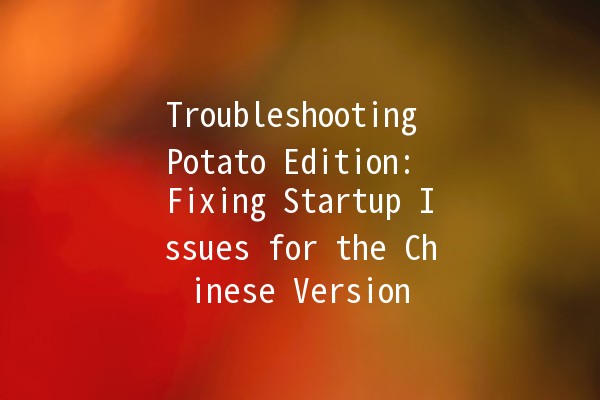As users of the Potato software often experience a variety of startup problems, this article will address common issues users face when launching the Chinese version of the application. We aim to provide practical tips and strategies that can help improve productivity while resolving these issues.
Understanding Potato Software and Its Challenges
The Potato application, a popular choice for many gamers and content creators, can sometimes present challenges upon startup. These challenges could arise from technical glitches, user configuration errors, or incompatibility with operating systems. Recognizing these issues is the first step towards effective troubleshooting. Knowing how to effectively handle these problems will not only streamline your use of the software but will also enhance your overall productivity.
Common Startup Issues

Productivity Enhancement Techniques
To address these common issues effectively, we can leverage specific techniques and strategies.
Description
One of the simplest yet most effective methods to resolve software startup issues is to restart your PC. This clears temporary files and reschedules processes that may be creating conflicts.
Practical Application
How to Do It: Save your work and restart your computer. Once it powers back on, attempt to launch the Potato software again.
Outcome: Often, a simple restart will resolve minor conflicts caused by temporary system issues or loading errors.
Description
Ensuring you have the latest version of Potato software can eliminate bugs and compatibility issues that might be causing startup problems.
Practical Application
How to Do It: Navigate to the Potato website or your application library and check for updates. Download and install any available patches.
Outcome: This can reduce the likelihood of running into known bugs, which could be causing the application to hang or crash during startup.
Description
Before installation, Potato software has specified system requirements related to memory, processing power, and graphics capabilities. Users need to ensure their systems meet these needs.
Practical Application
How to Do It: Refer to the Potato software’s documentation to confirm your system’s specifications. If necessary, consider upgrading hardware components or optimizing system performance.
Outcome: Meeting these requirements can lead to smoother operation and fewer errors during launch.
Description
Corrupt files can often result from a faulty installation. A fresh install can remedy this issue.
Practical Application
How to Do It: Uninstall the Potato software via your system’s settings, then delete any leftover files. Afterward, download the software from the official site and perform a clean install.
Outcome: This is likely to restore the software to its operational state, eliminating errors arising from corrupt files or configurations.
Description
Sometimes, the Potato application may not be fully compatible with your operating system, especially if you are running an older edition of Windows or macOS.
Practical Application
How to Do It: Rightclick on the Potato software icon, select "Properties," then go to the "Compatibility" tab. Enable compatibility mode for your operating system.
Outcome: This may resolve conflicts stemming from software and operating system version disparities.
Description
Background applications consuming system resources can significantly hinder the performance and startup of the Potato software.
Practical Application
How to Do It: Utilize the task manager to review running applications. Close any unnecessary programs before attempting to launch Potato.
Outcome: Minimizing resource consumption can give Potato the operating space it needs to launch smoothly.
Frequently Asked Questions
Q1: What should I do if Potato software is still not responding after a restart?
If the Potato software remains unresponsive, attempt reinstalling it. Additionally, check if your system meets all required specifications.
Q2: How can I identify if there are software updates available?
Users can check for updates within the application or through the official Potato website to ensure they're running the latest version.
Q3: Can I run Potato on older operating systems?
While it may work, older operating systems could lead to incompatibility issues. It’s best to run the application on suggested system configurations.
Q4: What are the risks of using unofficial sources to install Potato?
Installing from unofficial sources can lead to malware infections or corrupt files, posing significant risks to system integrity and personal information.
Q5: How do I check my computer’s specifications?
You can find system specifications by rightclicking "This PC" on the desktop and selecting "Properties" or using the "System Information" application.
Q6: Is it necessary to disable antivirus while using Potato?
While some antivirus software can falsely flag Potato, it’s not advisable to disable it. Instead, you can add Potato to your antivirus's whitelist to prevent blocking.
al Thoughts
Though issues with the Potato Chinese version can be frustrating, utilizing the techniques provided can significantly enhance your productivity and user experience. Whether it involves restarting your computer, updating software, or ensuring compatibility, each method represents a viable strategy for combating startup challenges. Embracing a systematic approach to troubleshooting can save time and mitigate stress, enabling you to focus on maximizing your use of the Potato application.
Consistent practice of these tips will not only optimize your experience but will also empower you with the knowledge to tackle similar challenges in the future. Enjoy leveraging Potato software to achieve your creative endeavors!